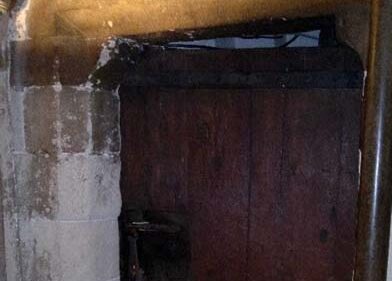
As you walk through a passageway that links the cloisters to the Chapter House in Westminster Abbey, you walk past a doorway that is generally lit with a spotlight on a stand. Next to it is a sign: ‘Britain’s Oldest Door’.
Constructed from five oak planks held together with iron bars or straps (one on the outside of the door, two on the inside) and wooden battens, the door also has a solid-looking iron lock and faceplate. Dendrochronology (the science of dating wooden objects from their inherent tree rings) has established that the tree from which this door was made was cut down sometime around 1032CE, and the door made in the 1050s. It is, therefore, an anglo saxon door, made in the reign of Edward the Confessor, the king responsible for the building of the first grand abbey church at Westminster (and whose shrine is in the chapel behind the high altar).
Although the door is 6.5′ (about 2m) high, it is thought that it was once even bigger – probably around 9′ (2.8m), and with a rounded top to fit into an arched doorway. When Henry III started the rebuilding of the Confessor’s Abbey in the 13th century, the door was cut down in size and moved to its current position. (The door – which was once very grand, and covered in hide – must surely have been across a significant entrance way.)
I’ve read blog posts in the past that suggest that because oak trees can live for hundreds of years, that the tree from which the wood was taken to make the door might have been growing when Britain was part of the Roman Empire (i.e. before the beginning of the 5th century), but this is fanciful. The tree rings (dendrochronology again) indicate the years that the wood was growing were between 924CE and 1030. That 924 date is, though, pretty remarkable when one considers that it was in 927 that Aethelstan conquered Northumbria and became the first king to rule the whole of England. We can therefore make a case for saying that the door is older than England itself.
And what is behind this oldest, most famous of doors? Surely there must be some sort of treasures, or a stairway to an old and glorious part of the Abbey? A couple of years ago I noticed as I walked past it that someone had left a light on in the room behind. Hoisting myself up on the stone seat that runs along the wall of the passageway I peered through the gap that is at the top of 1,000 year old door and saw…
…a small store room, with half a dozen cardboard storage boxes and the gardener’s leaf blower. (Alexa – explain ‘bathos’.)
